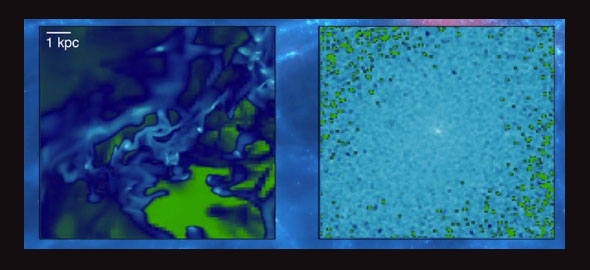|
||||
Chilean scientist simulate the growth of black holes
By using computational simulations, two scientists from the Astronomy Departament at University of Chile reproduced the growth of the first black holes in the Universe. The work was published today at Monthly Notice of Royal Astronomical Society (MNRAS).
The study has the title: "Multiscale mass transport in z~6 galactic discs: fueling black holes"and was done by the post-doctoral researcher Joaquín Prieto Brito in collaboration with Prof. Andrés Escala Astorquiza. Both researchers work at the Departamento de Astronomía de FCFM de la Universidad de Chile and researcher at the Center for Excellence in Astrophysics and Associated Technologies.
For Prieto the main goal of the paper was "to understand how black holes grew inside the first galaxies of our Universe". Such an study can help to understand how the observed super massive black holes grew so fast in the first billion years of our Universe.
One of the main conclusions of the work was that "the gas can flow from the outer edge of the galaxies to its center due to the combined effects of gravity and turbulence - violent movements of the fluid - dominating the gas". Such processes "allow the matter to reach the central galactic region feeding efficiently the black holes to eventually produce the super massive black holes observed as quasars (very bright and distant objects)", concluded the astrophysicist.
How they did it?
In order to perform their study, the scientists used computational simulations "to reproduce the movement of huge gas volumes where was possible to visualize how the matter flow in the first galaxies", explained Prieto.
The simulations were run in the Center for Matematical Modeling (CMM) FCFM of the University of Chile, where is located the national laboratory of high performance computing (NLHPC). In this laboratory works the most powerful computer in the country.
The results were analysed in the Geryon2 cluster, located at the Institute of Astrophysics of the Pontificia Universidad Católica de Chile.
Prieto says that they run 3 computational simulations. Each of them lasted between 2 and 3 weeks: almost two month of computation in 240 processors in the Leftraru cluster. It is equivalent to a 40 years of computation in a personal standard computer. Furthermore, the data analysis lasted 5 months more ending with a total of 7 month of work.
After these first results, both researchers are planning new simulations including more astrophysical processes to try to understand how the first galaxies evolved and how they allowed the rapid growth of black holes to form the observed super massive black holes in the first billion of years of our Universe.
In order to see the original publication at MNRAS please see the following URl http://mnras.oxfordjournals.org/content/460/4/4018
|
|
Share | Tweet |

|
||
|




